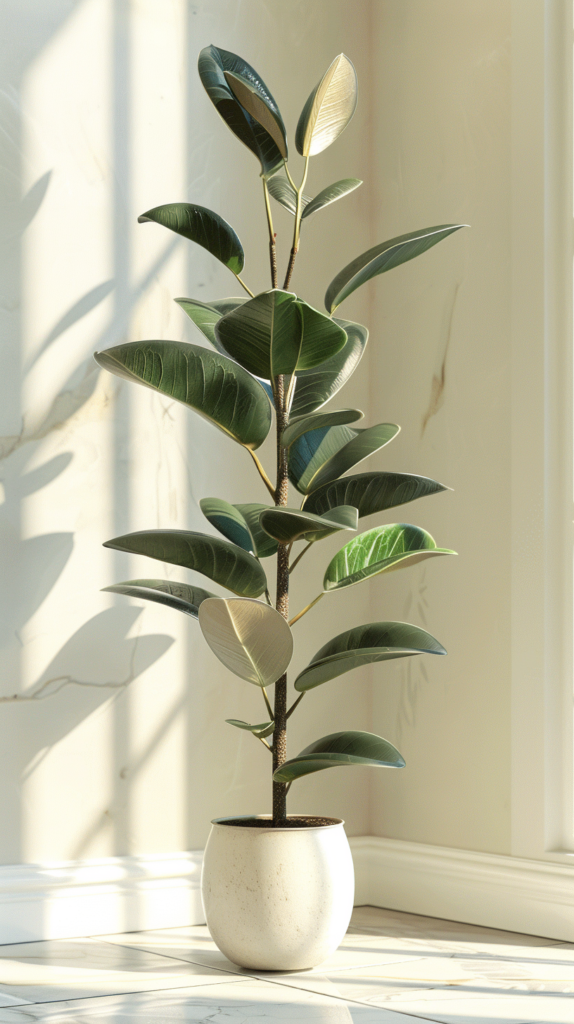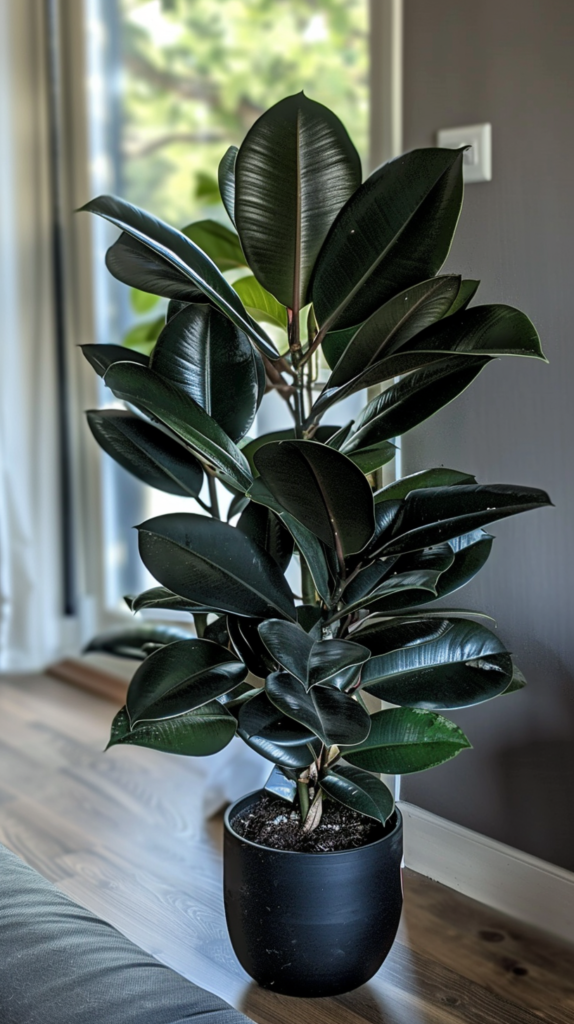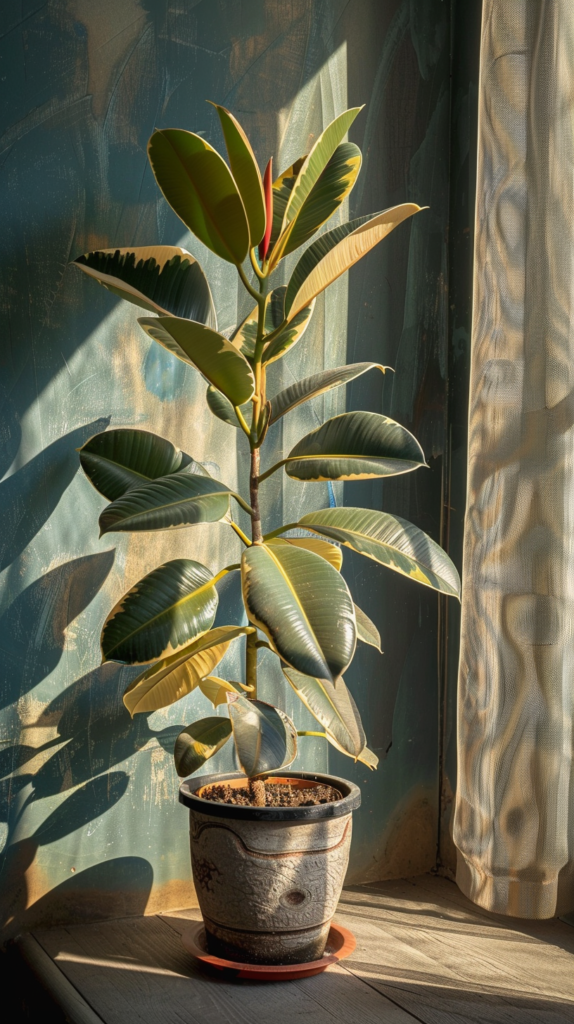Disclosure: Some links on this site are affiliate links. As Amazon Associates, we earn from qualifying purchases (at no cost to you).
Rubber plants, known scientifically as Ficus elastica, are popular houseplants for their attractive, glossy leaves and their ability to adapt to various indoor environments.
Whether you’re a seasoned plant parent or a newbie, these 10 rubber plant care tips will help you keep your Ficus elastica healthy and thriving.
- MODERATE LIGHT – Can Thrive in a low to Moderate Indoor or Outdoor Enviroment
- EASY CARE – Our Rubber Plant Will Not Require Constant Attention, Will Thrive on Being Watered when the soil is dry
- UNIQUE FOLIAGE – The Rubber Tree ‘Burgundy’ has Beautiful Deep Red colored Leaves that are striking in any setting

1. Choose the Right Spot
Rubber plants love light, but not just any light. They thrive best in bright, indirect light. Direct sunlight can scorch their leaves, while too little light can lead to weak, leggy growth.
Find a spot near a window where the plant can get plenty of filtered light throughout the day. An east-facing window is often ideal, as it provides gentle morning sun.

If you notice your rubber plant leaning towards the light source, give it a quarter turn every few weeks to ensure even growth. This helps maintain a balanced shape and prevents one side from becoming too heavy and potentially causing the plant to topple.
2. Water Wisely
Watering is crucial, and rubber plants can be picky about their hydration needs. Overwatering is one of the most common problems and can lead to root rot. To avoid this, let the top inch of the soil dry out before watering again. Stick your finger into the soil to check the moisture level. If it feels dry, it’s time to water.

When watering, do so thoroughly until water starts to drain out of the bottom of the pot. Ensure the pot has good drainage to prevent water from sitting at the bottom. In winter, reduce the watering frequency as the plant’s growth slows down.
3. Maintain Humidity
Rubber plants are native to tropical regions, so they appreciate a bit of humidity. While they can tolerate average indoor humidity levels, they thrive in slightly higher humidity.
If your home is particularly dry, especially in winter, consider using a humidifier or placing the plant on a pebble tray with water. Misting the leaves occasionally can also help maintain humidity.
4. Fertilize During Growing Season
To keep your rubber plant looking lush and healthy, fertilize it during the growing season, which typically runs from spring through early autumn.
Use a balanced, water-soluble fertilizer diluted to half strength. Fertilize once a month during this period.
Avoid fertilizing in the winter when the plant is not actively growing, as this can lead to fertilizer burn or excessive growth that the plant cannot support.

5. Prune for Shape and Health
Pruning your rubber plant helps maintain its shape and encourages new growth. Regularly remove any yellowing or dead leaves to keep the plant looking tidy.
If your plant becomes too tall or leggy, you can trim the stems back to your desired height. Pruning encourages branching, making the plant bushier and more attractive.
Use clean, sharp pruning shears to make clean cuts and avoid damaging the plant. Always cut just above a node (where a leaf attaches to the stem) to promote new growth from that point.
6. Repot When Necessary
Rubber plants don’t need to be repotted frequently, but it’s essential to give them more space as they grow.
Plan to repot every two to three years, or when you notice the roots becoming pot-bound and growing out of the drainage holes.
Choose a pot that is one size larger than the current one and use fresh, well-draining potting soil. Carefully remove the plant from its old pot, gently loosen the roots, and place it in the new pot. Fill in with soil and water thoroughly.

7. Keep an Eye on Pests
Rubber plants are relatively pest-resistant, but they can still fall victim to common houseplant pests like spider mites, mealybugs, and scale insects.
Regularly inspect your plant for signs of pests, such as small webs, white cottony masses, or sticky residue on the leaves.
If you notice any pests, treat them promptly with insecticidal soap or neem oil. For minor infestations, wiping the leaves with a damp cloth can help remove pests. Keeping your plant healthy and stress-free is the best defense against pests.

8. Provide Adequate Air Circulation
Good air circulation is vital for preventing fungal diseases and keeping your rubber plant healthy. Avoid placing your plant in stagnant areas or too close to walls and other objects.
Allowing space around the plant helps air to flow freely and reduces the risk of mold and mildew.
If you notice any signs of fungal issues, such as black spots on the leaves or a musty smell, improve air circulation and reduce watering until the problem resolves.
9. Clean the Leaves
Dust can accumulate on the broad leaves of a rubber plant, blocking sunlight and hindering photosynthesis. Regularly clean the leaves with a damp cloth to keep them shiny and healthy.
This not only improves the plant’s appearance but also helps it absorb more light.
Avoid using leaf shine products, as these can clog the plant’s pores and lead to other issues. A simple wipe with water is sufficient to keep the leaves clean.
10. Be Patient and Observant
Every plant is unique, and your rubber plant may have specific needs based on its environment. Be patient and observant, and don’t be afraid to adjust your care routine as needed.
Pay attention to the plant’s signals—yellow leaves might indicate overwatering, while drooping leaves could mean it’s thirsty or too cold.

FAQ
Q: How often should I water my rubber plant? A: Water your rubber plant when the top inch of soil feels dry. This usually means watering once a week during the growing season and less frequently in winter.
Q: Can I place my rubber plant in direct sunlight? A: Rubber plants prefer bright, indirect light. Direct sunlight can scorch their leaves, so it’s best to place them near a window with filtered light.
Q: How do I increase humidity for my rubber plant? A: Increase humidity by using a humidifier, placing the plant on a pebble tray with water, or misting the leaves occasionally.
Q: What should I do if my rubber plant has pests? A: Inspect your plant regularly for pests and treat infestations promptly with insecticidal soap, neem oil, or by wiping the leaves with a damp cloth.
Q: When should I repot my rubber plant? A: Repot your rubber plant every two to three years or when the roots become pot-bound and grow out of the drainage holes.

Final Thoughts
Rubber plants are beautiful, resilient houseplants that can thrive with the right care. By following these 10 tips, you can keep your Ficus elastica healthy and vibrant, adding a touch of natural elegance to your home.
Remember to be patient and observant, adjusting your care routine as needed to meet the specific needs of your plant.
With a little attention and love, your rubber plant will flourish and become a stunning focal point in your indoor garden. Happy gardening!





